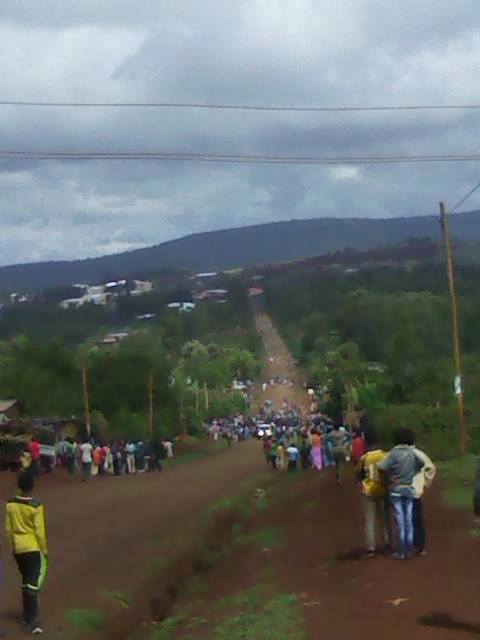Addis Ababa is growing fast and set to expand further, pitting the government against Oromo activists, seeking to protect their rights.

Gambia Street in downtown Addis Ababa, Ethiopia, bustles with traffic. Credit: David Stanely
Ethnic Oromo students in Ethiopia are ratcheting up opposition to the territorial expansion of the Horn of Africa nation’s capital, Addis Ababa. Thousands of students at all eight regional universities in Oromia, the largest of Ethiopia’s federal states, turned in recent days to demand an immediate halt to the city’s so-called “Integrated Development Master Plan,” unveiled earlier this month.
Today, Tuesday 29 April, an estimated 25,000 people, including residents of Ambo town in central Oromia, participated in a city wide demonstration, in the largest show of opposition to the government’s plans to date. A handful of students have been injured and others arrested in protests at the campuses of Jimma, Haromaya, Ambo, Wollega, Metu, Bolu Hora, Adama and Maddawalabu universities, according to local reports.
Once dubbed a “sleeping beauty,” by Emperor Haile Selassie, Addis Ababa is an awakening city on the move. Vertically, buoyed by a growing economy and rural to urban migration, there is construction almost on every block — so much so that locals refer to it as “a city under construction.” The country’s first light rail transit which will connect several inner city neighbourhoods, being constructed with the help of the China Railway Group Ltd, is reported to be 60% complete. Horizontally, over the last decade, not least due to an uptick in investment from returning Ethiopian expats from the U.S. and Western Europe, the city has expanded at a breakneck pace to swallow many surrounding towns.
Addis Ababa’s rapid urban sprawl is also getting noticed abroad. In 2013, it’s the only African city to make the Lonely Planet’s annual list of “top 10 cities to visit.” In April 2014, in its annual Global Cities Index, New York-based consultancy A.T. Kearney named Addis Ababa, “the third most likely city to advance its global positioning” in sub-Saharan Africa, only after Johannesburg and Nairobi. If it maintains the pace of development seen over the last five years, Kearney added, “the Ethiopian capital is also among the cities closing in fastest on the world leaders.”
Overlapping jurisdictions
Founded in 1886 by emperor Menelik II and his wife Empress Taytu Betul, Addis Ababa sits at the heart of the Oromia Regional State. According to the country’s constitution, while semi-autonomous, Addis Ababa is treated as a federal district with special privileges granted to the Oromia region, for which it also serves as the capital.
The Addis Ababa City Administration, the official governing body, has its own police, city council, budget and other public functions overseen by a mayor. The overlapping, vague territorial jurisdictions have always been the subject of controversy. Now contentions threaten to plunge the country into further unrest.
Home to an estimated 4 million people, Addis Ababa offers Ethiopia one of the few gateways to the outside world. The state-run Ethiopian airlines, one of the most profitable in Africa, serves 80 international cities with daily flights from Addis to Europe, different parts of Africa, the United States, Canada, Asia and the Middle East.
In addition to being the seat of the continental African Union, the city hosts a number of United Nations regional offices, including the United Nations Economic Commission for Africa. There are also more than 100 international missions and foreign embassies based in Addis, earning it the nickname of ‘Africa’s diplomatic capital.’ All these attributes require the city to continually grow to meet the needs and expectations of a global city.
City officials insist the new “master plan”, the 10th iteration since Addis Ababa began using modern city master plans in 1936, will mitigate the city’s disorganised growth and guide efforts to modernize it over the next 25 years.
According to leaked documents, the proposed plan will expand Addis Ababa’s boundaries to 1.1 million hectares, covering an area more than 20 times its current size. Under this plan, 36 surrounding Oromia towns and cities will come under Addis Ababa’s jurisdiction. Oromo students, opposition and activists say the plan will undermine Oromia’s constitutionally granted special interest.
A history of problematic growth
Addis Ababa’s spatial growth has always been contentious. The Oromo, original inhabitants of the land, have social, economic and historical ties to the city. Addis Ababa, which they call Finfinne, was conquered through invasion in 19th century. Since its founding, the city grew by leaps and bounds. But the expansion came at the expense of local farmers whose livelihoods and culture was uprooted in the process. At the time of its founding, the city grew “haphazardly” around the imperial palace, residences of other government officials and churches. Later, population and economic growth invited uncontrolled development of high-income, residential areas — still almost without any formal planning.
While the encroaching forces of urbanisation pushed out many Oromo farmers to surrounding towns and villages, those who remained behind were forced to learn a new language and embrace a city that did not value their existence. The city’s rulers then sought to erase the historical and cultural values of its indigenous people, including through the changing of original Oromo names.
Ultimately, this one-time bountiful farm and pasture land from which it draws the name Addis Ababa – meaning ‘new flower’ – where Oromos made laws under the shades of giant sycamore trees, grew foreign to them by the day. It is this traumatic sense of displacement that elicits deep passions, resentment and resistance from the Oromo community. The Oromo are Ethiopia’s single largest ethnic group, numbering over 25 million – around 35% of the total population – according to the 2007 census.
Ethiopia’s constitution makes a pivot to Addis Ababa’s unique place among the Oromo. Article 49 (5) of the constitution stipulates, “the special interest of the state of Oromia with respect to supply of services, the utilisation of resources and joint administrative matters.”
The Transitional Government of Ethiopia, which drafted the constitution, was fully cognisant of the potential conflicts of interest arising from Addis Ababa’s unbridled expansion, when it decided “to limit its expansion to the place where it was before 1991 and to give due attention to its vertical growth,” according to Feyera Abdissa, an urban researcher at Addis Ababa University.
But in the city’s 1997-2001 master plan, which has been in effect over the last decade, the city planners determined vertical growth posed key urbanisation challenges. In addition, most of Addis Ababa’s poor cannot afford to construct high-rise dwellings as per the new building standards. Officials also noted that the city’s relatively developed infrastructure and access to market attract the private investment necessary to bolster its coffers; the opening up to privatisation contributed to an upswing in investment. According to Abdissa, during this period, “54% of the total private investment applications submitted in the country requested to invest in and around Addis Ababa.” In order to meet the demand, city administration converted large tracts of forest and farmland in surrounding sub-cities into swelling urban dwellings, displacing local Oromo residents.
Local self-rule
In 2001, in what many saw as a conspiracy from federal authorities, the Oromia regional government decided to relocate its seat 100kms away, arguing that Addis Ababa was too “inconvenient” to develop the language, culture and history. The decision led to Oromia-wide protests and a brutal government crackdown, which left at least a dozen people, including high school students, dead. Hundreds of people were also arrested. In 2005, regional authorities reversed the decision amid internal pressures and protracted protests in the intervening years.
But the current opposition to the city’s expansion goes far beyond questions of self-rule. Each time Addis Ababa grew horizontally, it did so by absorbing surrounding Oromo sub-cities and villages. Many of the cities at the outskirts of the capital today, including Dukem, Gelan, Legetafo, Sendafa, Sululta, Burayu, Holeta and Sebeta, were one-time industrious Oromo farmlands. While these cities enjoy a level of cooperation with Addis Ababa on security and other issues of mutual interest, they have all but lost their Oromo identity. If the proposed master plan is implemented, these cities will come directly under Addis Ababa City Administration — thereby the federal government, further complicating the jurisdictional issue.
Among many other compromises made possible by Ethiopia’s ethnic federalism, each state has adopted the use of its native tongue as the official language of education, business and public service. In theory, the country’s constitution also grants autonomous self-rule to regional states. Under this arrangement, each state makes its own laws and levy and collect taxes.
In contrast, municipalities that fall under federal jurisdiction, including Addis, are governed by their own city administrations and use Amharic, Ethiopia’s federal working language. For the Oromo, as in the past, the seceding of surrounding towns to Addis means a loss of their language and culture once more, even if today’s driving forces of urbanisation differ from the 19th century imperialist expansion.
As seen from its recent residential expansions into sub-cities on the peripheries such as Kotebe, Bole Bulbula, Bole Medhanialem, Makanisa and Keranyo, the semi-agrarian community, including small, informal business owners, were given few options. The city’s new code requires building high-rises that are beyond their subsistence means. Unable to comply with the new city development code, the locals were pressured into selling their land at very low prices and eke out a living in a city that faces chronic unemployment. As a result, the horizontal expansion and displacement of livelihoods turned a one time self-sufficient community into street beggars and day labourers.
Activists fear that the latest expansion is part of a grand plan to contain a resurgent Oromo nationalism. As witnessed during the 2001 protests, any attempt to alter Addis Ababa’s administrative limits, unites Oromos across religious, regional and political divides. Unless halted, with a steam of opposition already gathering in and outside of the country, the ongoing of protests show ominous signs.
In a glimpse of the fervent opposition that could quickly turn deadly, within weeks after the plan was unveiled, two young and upcoming Oromo artists have released new music singles lamenting the city’s historic social and cultural heritage. One of the singers, Jafar Yusef, 23, was arrested three days after releasing his musical rendition — and has reportedly been tortured. Despite the growing opposition, however, the Addis Ababa municipal authority is vowing to forge ahead with the plan, which they say was developed in consultation with a team of international and local urban planners. Federal Special Forces, known as Liyyu police, who have previously been implicated in serious human rights violations, have been dispatched to college towns to disperse the protests. Soldiers in military fatigues have laid siege to several campuses, preventing students from leaving, according to eyewitness reports.
Trouble at the top while those at the bottom lack the basic necessities
The city administration is also riddled by a crippling legacy of corruption, massive inefficiency and poor service delivery. Its homeless loiters in the crowded streets that are shared by cars, pedestrians and animals alike. There are few subsidised housing projects for poor and low-income families. Many of the residents lack clean drinking water, healthcare and basic education. While some progress had been made to upgrade the city’s squatter settlements, the city is full of dilapidated shacks. Despite poor drainage system and other infrastructural deficiencies, studies show that there is a general disregard for health and environmental hazards in Ethiopia’s urban redevelopment scheme.
A lot of these social and economic problems are caused by the city’s poorly conceived but dramatic urban expansion. In the last two-decades, in an effort to transform the city into a competitive metropolis, there have been an uptick in the construction of high-rise buildings, luxury hotels and condominiums, which displaced poorer inhabitants, including Oromo farmers. “No one is ensuring the displaced people find new homes, and there are no studies about what his happening to them,” Mara Gittleman of Tufts University observed.
Regardless, the outcome of the current controversy will likely test Ethiopia’s commitment to ethnic federalism. The advance of the proposed master plan would mean further estrangement between the Oromo masses and Oromia regional government. Long seen as a puppet of the federal regime, with substantial investment in cultural and infrastructural development, regional leaders are only beginning to sway public opinion. Allowing the master plan to proceed would engender that progress and prove suicidal for the Oromo Peoples’ Democratic Organization (OPDO), the Oromo element in Ethiopia’s ruling coalition. In the short run, the mounting public outcry may not hold much sway. The country’s one-time vibrant opposition is disarray and the ruling Ethiopian People’s Revolutionary Democratic Front (EPRDF) has almost complete control of the political system.
The opposition to the expansion plans does not pose an immediate electoral threat to the EPRDF who, controlling the system as they do, are likely to claim an easy victory in next year’s elections. However, opposition, and the government’s possible aggressive response to it, could make Oromo-government relations more difficult. The government now has a choice, violently crackdown on protestors, labelling them “anti-development”, or engage with them as stakeholders representing historically marginalised communities. Ethiopia’s federal constitution suggests the latter course of action; sadly, recent history may suggest the former.
Source: Think Africa Press
APRIL 29, 2014
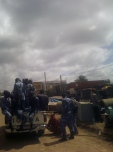
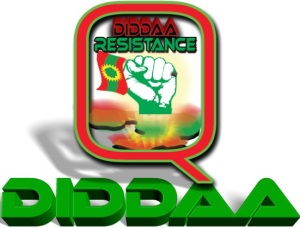
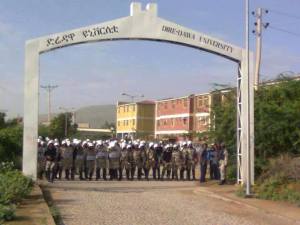

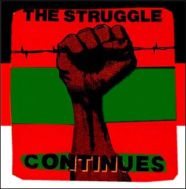

 Mrs Aster Mamo, the Deputy Chairwoman of the regional ruling party Oromo Peoples Democratic Organization (OPDO) said her party is pleased with the Oromo student protests happening in universities throughout Oromia. This week, thousands of Oromo students have demonstrated in several universities to express their concerns about the government’s investment plan around the capital Addis Ababa.
Mrs Aster Mamo, the Deputy Chairwoman of the regional ruling party Oromo Peoples Democratic Organization (OPDO) said her party is pleased with the Oromo student protests happening in universities throughout Oromia. This week, thousands of Oromo students have demonstrated in several universities to express their concerns about the government’s investment plan around the capital Addis Ababa. Elevated at 2000 meters above sea level overlooking most of the country, Addis Ababa remains at center of Ethiopia’s political and economic life for the past 126 years. Historically, handpicked by Emperor Menelik II to administer his expanding kingdom, mainly for its strategic defense advantages, Addis’s preeminence grew, even in the continent, over time.
Elevated at 2000 meters above sea level overlooking most of the country, Addis Ababa remains at center of Ethiopia’s political and economic life for the past 126 years. Historically, handpicked by Emperor Menelik II to administer his expanding kingdom, mainly for its strategic defense advantages, Addis’s preeminence grew, even in the continent, over time. The Ethiopian authorities should immediately release six bloggers and three journalists arrested on April 25 and 26, 2014, unless credible charges are promptly brought, Human Rights Watch said today.
The Ethiopian authorities should immediately release six bloggers and three journalists arrested on April 25 and 26, 2014, unless credible charges are promptly brought, Human Rights Watch said today.